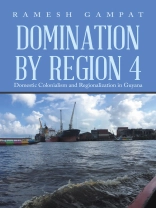This book argues that Guyana presently operates a system of domestic colonialism (DM). DM builds on institutions established during imperial colonialism, strengthened and expanded since independence in 1966, and regionalization, which balkanized the country into ten administrative regions. Regionalization is a flexible instrument that enables political and economic control, with one strengthening the other, further empowering Region 4 where the “metropole” is located, and enhancing the dependency of the nine satellite regions. Both political parties exploits regionalization when in power, the PPP principally through financial strangulation and discrimination, the PNC and its various incarnations via political control. Regionalization is the symbol of domestic colonialism.
PPP-I (last six years of its previous regime, 2009 to 2014) allocated an annual average of 11.1 percent of public funds to the regions, the APNU+AFC 14.1 percent from 2015 to 2020, and PPP-II, the current PPP administration, 12.5 percent during its first two years in office. Over the fourteen-years from 2009 to 2022, the four largest agencies consumed 42.5 percent of total Central Government expenditure. Under PPP-I, these agencies spent 15 percentage points more on capital costs than they did under APNU+AFC. However, under the latter government they spent more than 10 percentage points on the amorphous category “Other Charges.” These anomalies are hard to explain because there were no functional enhancements or reach of coverage by these agencies. Incredibly, the Ministry of Finance (Mo F), the largest agency for all but one year, spent 46.1 percent of what the Ministry of Public Works incurred on public infrastructure for the entire country.
An important avenue of political patronage is the employment of contract and temporary workers, who are hired outside of the public service legislative framework. These workers comprised half of the Mo F’s workforce over the fourteen-year period and the last six years of PPP-I; for the Ministry of Health, that figure is around 37.0 percent for both periods. Employment patronage rose during APNU+AFC’s term of office, to 53.8 percent in the Mo F and to 41.8 percent in the Mo H. Employment patronage at these two big agencies was lower during PPP-I than the six years of the APNU+AFC Government.
“Patronage employment” is considerably lower with the PPP-II than all previous regimes. The strategic deviation is explained by the rise of three separate categories of low- and unskilled workers, who account for 48.5 percent and 57.7 percent of workforce of the Mo F and the Mo H, respectively. These figures are more than 10 percentage points larger than those of all previous administrations. In effect, the PPP doles out patronage away from hiring outside of the public service legislative framework to hiring within it. Not only has the PPP “legalized” patronage, it has also increased it significantly.
Giới thiệu về tác giả
Ramesh Gampat is an economist, who worked for about three decades with the United Nations Development Programme. He is the author of several books. The two most recent ones are Guyana’s Great Economic Downswing, 1977-1990. Socio-Economic Impact of Co-operative Socialism (2020); and Essays. Guyana: Economics, Politics and Demography (2022). Dr. Gampat has also published academic papers on inflation, poverty, international trade, human development, gender and corruption. He lives with his wife just outside Atlanta, Georgia.












